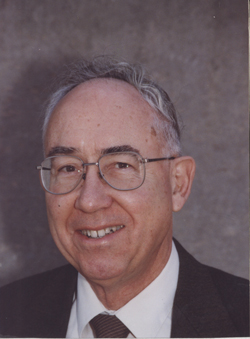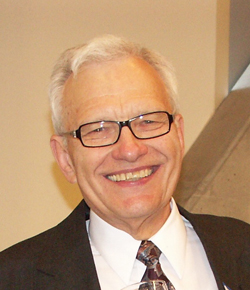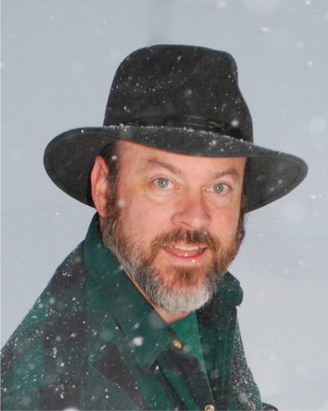History of AAPT — Journal Growth
We have noted that the first Association journal, then called The American Physics Teacher, began as a quarterly in 1933 with Duane Roller as editor. In 1938 the number of issues per year was raised from four to six, and at the annual meeting in December 1939 the name was changed to the American Journal of Physics; the first issue with the new title was that of February 1940. In 1948 the editorship of the journal was taken over by Thomas H. Osgood of Michigan State University, and under the new editor the number of issues per year was increased from six to nine.
The Association can be justly proud of the journal. Examination of the cumulative 20-year index, prepared in 1953, reveals a treasury of materials of interest to physicists generally but particularly to those concerned with physics education. There are articles on the history of physics, new ways of looking at old problems, simple direct ways of understanding recent advances, novel proofs, ingenious apparatus for laboratory and demonstration, general philosophical considerations, and many other topics. A selection of general articles was reprinted under the title On Teaching Physics (AAPT, Stony Brook, NY, 1980). A collection of reprints of historical articles from both AJP and TPT was published as Physics History from AAPT Journals (AAPT, College Park, MD, 1985). Both books were edited by Melba Phillips. In 1995 AAPT published Physics History from AAPT Journals II, edited by A.P. French and Thomas B. Greenslade, Jr. and dedicated to Melba Phillips.
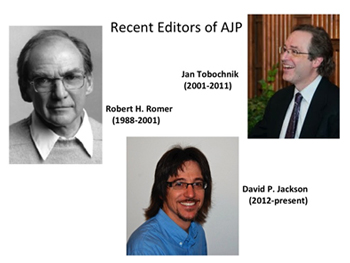 Professor Osgood resigned as editor in 1958, and Walter C. Michels of Bryn Mawr College became editor at the beginning of 1959. He served until 1966, except for a leave of absence during which Alfred Romer of St. Lawrence University was acting editor. In 1961 the American Journal of Physics became a monthly. Forrest I. Boley of Dartmouth College took over in 1966, and was succeeded by Edwin F. Taylor of MIT in 1973. The next in succession was John S. Rigden of the University of Missouri in St. Louis. He served from 1978-88. Robert H. Romer of Amherst College in Massachusetts served from 1988-2001. Jan Tobochnik, of Kalamazoo College, in Kalamazoo, Michigan edited AJP from 2001-2011. In 2012 David P. Jackson from Dickinson College in Carlisle, Pennsylvania became the editor. Since 1944 the journal has profited from able assistant editors. Ten-year cumulative indexes have been published for the periods 1953-62, 1963-72, 1973-82, and 1983-92.
Professor Osgood resigned as editor in 1958, and Walter C. Michels of Bryn Mawr College became editor at the beginning of 1959. He served until 1966, except for a leave of absence during which Alfred Romer of St. Lawrence University was acting editor. In 1961 the American Journal of Physics became a monthly. Forrest I. Boley of Dartmouth College took over in 1966, and was succeeded by Edwin F. Taylor of MIT in 1973. The next in succession was John S. Rigden of the University of Missouri in St. Louis. He served from 1978-88. Robert H. Romer of Amherst College in Massachusetts served from 1988-2001. Jan Tobochnik, of Kalamazoo College, in Kalamazoo, Michigan edited AJP from 2001-2011. In 2012 David P. Jackson from Dickinson College in Carlisle, Pennsylvania became the editor. Since 1944 the journal has profited from able assistant editors. Ten-year cumulative indexes have been published for the periods 1953-62, 1963-72, 1973-82, and 1983-92.
In 1998, the Executive Board approved a motion to make available via the web an electronic version of AJP, which would begin with the January 1999 issue. In 2002, the Board approved a motion to place back issues of AJP online. In January 2004 issues from 1975-1998 will be available. In January 2005, issues from 1933-1974 will be available. [2007 Note: Back issues dating from 1933-2007 are available online.]
The second AAPT journal, The Physics Teacher, dates from the early 1960s. National concern for high school science teaching had grown during the late 1950s. The Physical Science Study Committee (PSSC), initiated in 1956 under the leadership of Jerrold R. Zacharias and Francis L. Freedman of MIT, had produced PSSC Physics, and the National Science Foundation (NSF) was supporting both Summer Institutes and Academic Year Institutes for the continuing education of science and mathematics teachers. It was clear that AAPT should be of service to all physics teachers, including those in high schools, but broadening AJP to emphasize high school concerns did not seem feasible. Under the leadership of Malcolm Correll, then AAPT President, a prospectus for a new journal was prepared in 1961, and a proposal was made to NSF for a grant to help it get under way.
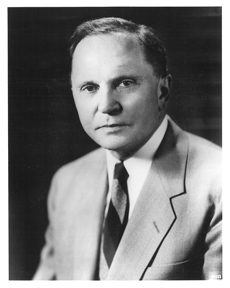 The first editor was J.W. Buchta, who was also the first Executive Secretary of the Association. He had served as editor of both the Physical Review and Reviews of Modern Physics, and had much firsthand acquaintance with American high schools. According to the masthead, “The Physics Teacher is dedicated to the enhancement of physics as a basic science in the secondary schools.”
The first editor was J.W. Buchta, who was also the first Executive Secretary of the Association. He had served as editor of both the Physical Review and Reviews of Modern Physics, and had much firsthand acquaintance with American high schools. According to the masthead, “The Physics Teacher is dedicated to the enhancement of physics as a basic science in the secondary schools.”
Through the grant from NSF, all teachers of high school physics received the journal without charge for the first year. The first issue was that of April 1963, and there were eight issues per year for several years. (There are now nine; the December issue made its appearance in 1968.) After the death of Buchta in 1966 the magazine was edited on a temporary basis by Robert Detenbeck, assisted by Philip DiLavore, both then at the University of Maryland.
In 1967 TPT came into the capable hands of Clifford Swartz of State University of New York (SUNY), Stony Brook. Under Swartz and his associate editors (first Lester G. Paldy and then Thomas D. Miner) high school physics was still central, but the journal embraced the teaching of introductory physics at all levels. In 1985, Donald Kirwan of the University of Rhode Island (URI), assisted by Jack Willis, also of URI, became the new editor. In 1989 TPT returned to SUNY-Stony Brook when Clifford Swartz once again became editor, assisted by Carole Escobar.
After a national search in 2000, Karl Mamola, of Appalachian State University in Boone, North Carolina, became editor. Andrew Graham, also of Appalachian State, became the assistant editor. TPT contains much of practical value, but its approach is by no means narrowly utilitarian. TPT and AJP are available in electronic format as a benefit of AAPT membership. Members may selected the print format for a small additional fee. (For a detailed history of the early years and an appreciation of J.W. Buchta, see the tenth anniversary issue of TPT, April 1973.)
In 2013 Karl Mamola announced his retirement as editor of TPT. Following a national search, Gary Dane White was hired as the new editor, beginning with the September issue that year.
In January 2003, TPT also made its full-text debut on the Internet. Five years of back issues were also posted at the same time.
